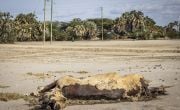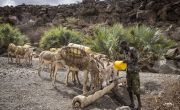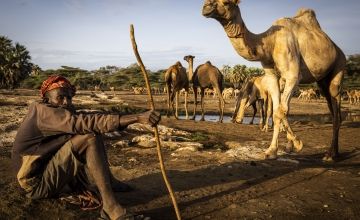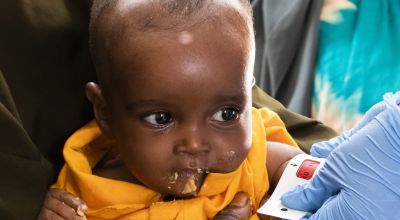
Read our 2024 annual report

Knowledge Hub
Last year, after another season of failed rains, that emergency was brought to a breaking point. And while rains have arrived in the Horn of Africa, it still faces a humanitarian crisis that’s far from over. Here’s what you need to know.
1. This was the worst drought to hit the Horn of Africa in over 40 years
The Horn of Africa is one of the epicentres of the climate crisis. Drought in Somalia has continued for over a decade; Ethiopia faced back-to-back droughts over seven years; and Kenya has experienced a cycle of drought that dates back to 1975.
After five consecutive failed rainy seasons, this most recent drought was the worst to hit the region since 1981. Water shortages destroyed thousands of acres of crops, killed livestock, and dried up water sources across all three countries — as well as water sources in parts of Sudan and South Sudan. (For context: A 2011 drought that hit the region left 13 million people in need of humanitarian assistance, and led to a famine in Somalia that killed over 260,000 people, half of whom were children under the age of five.) Last autumn’s failed “short” rainy season led to a truly unprecedented situation not seen in recent history.


2. Rains have arrived in east Africa, but that doesn’t mean the crisis is over
This spring’s “long” rainy season in east Africa was a success, but this much-needed relief doesn’t mean the crisis is over. In parts of Ethiopia and Somalia, excess rains have led to dangerous flash floods as the ground — after having little to no water in years — cannot absorb the water. Homes and farms have been destroyed as a result, and the flood conditions exacerbated the current global cholera outbreak. More flooding is also expected later this year, partly due to the forecasted El Niño cycle.
Aid agencies have been warning of the catastrophic consequences from the moment the long rains failed last year across the Horn of Africa, and have called for urgent action from as early as May 2021. Then, there was not much of an appetite for a response at a time when the situation was considered not to be severe. Sadly, we have now reached a point where what will shock us or get our attention are images of emaciated babies and animal carcasses. And that – I am sorry to say – is utterly repugnant.
3. People in the Horn of Africa rely on the land to live
Approximately 80% of Kenya is arid or semi-arid land, leaving most of the people who live in this region relying on pastoralism (herding livestock) for their livelihoods. In the last few years, herders have suffered significant losses and are facing challenges to their very way of life. As of January this year, 2.5 million livestock in Kenya died from the drought. In Somalia, 75% of residents live in rural areas, with 60% earning their living from herding and 15% from agriculture. There, over 3.5 million livestock have died due to the conditions. In Ethiopia, the numberis somewhere around 4.5 million.
“It’s very worrying when even camels, known for their ability to survive in extremely hot and dry conditions, are struggling to survive,” said Concern Kenya Country Director Arshad Muhammad last year.
“Over 8 million people rely on livestock for their livelihoods,” added Concern Ethiopia Country Director Barbara White. “But two million animals have perished and another 22 million are at risk of dying. They are weak and producing little milk, the main source of nutrition for children.”
Those numbers won’t go down overnight. According to Amina Abdulla, Concern's regional director for the Horn of Africa, if there are no more major shocks over the next ten years, cattle and camel herds will only return to 50% of their size in 2020. That’s a big “if.”

4. This isn’t just about the weather or the livestock
The loss of crops and livestock isn’t the end of the story. The effects of this latest drought in the Horn of Africa have been felt in rising incidences of gender-based violence, communicable diseases, and hunger rates. Many communities across Ethiopia, Kenya, and Somalia are facing hunger and food insecurity on unprecedented levels.
The Horn of Africa drought compounds a cycle of crisis in Somalia that has 7.1 million people (57% of the population) facing hunger. In Ethiopia, which has faced its own complex humanitarian situation, 20.1 million people go to bed hungry. In Kenya, 4.4 million people are facing similar conditions of food insecurity. “Where drought leads, hunger is never far behind,” says Concern Somalia Country Director Abdi Rashid Haji-Nur.
Where drought leads, hunger is never far behind.
Hunger in the Horn of Africa is furthered by inflation, with food prices at a premium in many of the areas affected by drought. This is in part due to the low supply and high demand of a compromised food system, but it’s also the result of a larger hunger crisis prompted by the conflict in Ukraine (a region that supplies much of the wheat imported by Somalia). The cost of a food basket in Ethiopia has risen by 66%, and in Somalia it’s gone up by 36%. For families already living in the cycle of poverty, this means many are having to make very tough decisions between selling off whatever assets they have — or going without food. For internally displaced communities or refugees living in host communities (especially in Ethiopia and Sudan), getting food and other life-saving items is even more of a challenge as rations have become more expensive to acquire and humanitarian organisations in the area are under-funded.
Women and girls are hit especially hard by drought as well. As they are often the ones responsible for gathering water, many now have to travel even further to find a water source, wasting precious time and opening themselves up to violence and injury. The UN Office for the Coordination of Humanitarian Affairs adds that the risk of gender-based violence has increased due to the deteriorating conditions. In Somalia, child marriage rates have increased as families struggle to keep everyone fed, and 1.4 million children are at risk for dropping out of school (420,000 of whom are girls). Families struggling to keep all of their children in school are prioritising the education of their sons over their daughters.

5. Crisis response has been underfunded, which will complicate recovery as well
In 2017, Somalia was at risk of another drought-related famine. A series of early warning and early action responses helped to avert this crisis. When the region’s long rains failed in the spring of 2021, agencies — including Concern — took action and sounded the alarm.
However, the international community did not respond in kind. One year later, funding for Ethiopia, Kenya, and Somalia was between 27% and 34% of the necessary amount to adequately address the crisis.
“Sadly, we have now reached a point where what will shock us or get our attention are images of emaciated babies and animal carcasses,” said Abdulla at the time. “And that — I am sorry to say — is utterly repugnant.”
This year, the United Nations co-hosted a pledge drive for the Horn of Africa, with $2.4 billion pledged (not yet raised). However, that is less than half of the estimated $7 billion needed to address the situation this year. Emergency food and nutrition conditions are expected to continue through the end of this year, if not into 2024, and the crisis could continue to deepen if funding does not meet the current need. This will cause families to fall further behind.
“Over the next six months, it is critical that urgent humanitarian assistance is provided to save lives and support recovery,” says Danny Harvey of Concern Worldwide UK. “The pledged funds need to be released swiftly, and through channels that reach affected communities, in order to save lives and prevent this tragedy from worsening.”

The Horn of Africa crisis: Concern’s response
With a range of services, Concern Worldwide’s teams in Ethiopia, Kenya, and Somalia reached 1.5 million people affected by the Horn of Africa drought last year. This included over 105,000 displaced people in Somalia — 8,600 of whom were children suffering malnutrition. In Kenya’s Tana River county, we worked with 11,000 families to cultivate more than 2,000 acres of drought-affected land using Climate Smart Agriculture techniques that build resilience against the effects of climate change.
In addition to our award-winning Community Management of Acute Malnutrition program, we are also continuing to provide cash transfers to drought-affected families, allowing them to buy essentials such as water and food. We’re also working with local healthcare services to support critical ongoing treatments through mobile medical teams; including services for maternal and child health and responses to increased cases of cholera and measles in certain areas. Where available, we’ve also trucked in water for communities.





